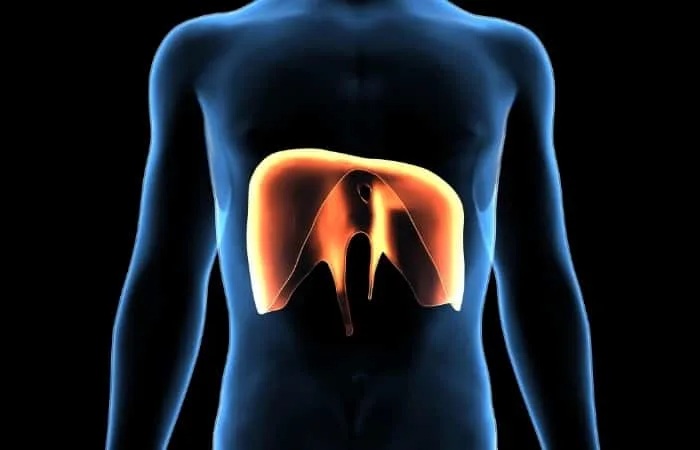Singing from the chest is a vocal register that’s often used in speech and song. It’s also known as “chest voice” or “middle voice.” You might be singing this way already without even realizing it!
Learning how to sing from your chest voice will help you find more vocal power, range, and control with your vocals. Plus, it’ll make singing easier on the throat.
Carry on reading to learn all about singing from your chest, along with how to do it.
What Is A Chest Voice (And The Other ‘Voices,’ For That Matter?)
When we speak or sing, our vocal cords (located at the cross-section of the throat) vibrate together to produce sound, and several registers have been defined.

The chest voice is deep, full, and strong low notes. It is a register where
1. Sympathetic resonance is felt from your chest.
2. Your vocal cords are thick, short, and vibrating fully against each other.
If you play a string instrument, this corresponds with the strings that produce a lower pitch. Do you notice that they are often thicker? That’s what your vocal cords are doing in your chest voice.

Another way of visualization is if you place both your outstretched index fingers together. This is how your vocal cord looks in your chest voice.
On the other end of the spectrum, we have falsetto. Falsetto is when
1. Resonance is felt in the head.
2. Your vocal cords are thin, long, and open, allowing a lot of air to come out through them, resulting in a whispery quality.
To test this, put your hand in front of your mouth when you sing. If you feel a lot of air, you are probably singing in falsetto.

We also have the magical head voice, where
1. Resonance is felt in the head
2. Your vocal folds are thin, long, but not completely open, allowing limited air to come through them, resulting in a “blended” voice between chest voice and falsetto that is powerful yet effortless.
The best singers manage to blend all of these registers, so the listener does not realize that the singer is “shifting gears.”
You’re likely to be curious about how to sing high notes from your chest, which is defined as belting.
What you need:
Your body. Singing involves your entire body, not just your throat!
Step 1: Warm Up Your Body
First up: releasing tension in your body.
Stretch your neck, back, and legs with a slow forward fold, bending your body 90 degrees at the waist. Let your neck and head hang, feeling the stretch in the back of your legs while keeping the upper body relaxed. Stand up slowly.

Massage your jaw, face, the muscles on the sides of your neck, and your chest muscles underneath the collar bone.

If you sit at a computer all day, it’s a good idea to stretch out your shoulders and open up your chest. Reach behind you and clasp your hands together to stretch out your shoulders and release any tension there. Activate nerve endings in your sit muscles, for example, your lower back, buttocks, and upper thighs, by massaging these areas as well.

Now it’s time to get your blood circulating! Start by standing with your feet width wider than your hips. Then reach up to the sky and grab at the air repeatedly, alternating between your hands. Do it sideways, then down to the ground.
Do 10 jumping jacks, followed by 10 lunges on each leg.
You need energy for belting!

Step 2: Identify The Place Your Resonance Comes From
Place both your hands on your sternum, i.e., your upper front chest, and say “Hello there” strongly and confidently. You should feel your chest vibrating.
If it does not, try saying “hey” in a lower register.

Step 3: Relax And Breathe Deeply
Use a mirror to check if you are breathing deeply enough. Put your hand on the middle of your upper belly, around the last ribs from the bottom of your ribcage. Take a deep breath, and your stomach should expand slightly. This is what is called diaphragmatic breathing.
Note on the diaphragm: The diaphragm is an involuntary muscle, and we cannot directly control the diaphragm’s movements; we can only influence how it rises and falls with the correct posture and muscle engagement.

If you see your shoulders rising, you are breathing shallowly. To counter that, think about breathing into your feet and imagine they are expanding.

Step 4: Get Into Position
Keep your feet hip-distance apart (this is often closer than people think!) Use a mirror. This maintains integrity with your lower back.
Check that your shoulders are relaxed, and you are standing upright, hands by your sides.
Step 5: Warm Up Your Voice
Start by singing some scales if you have a piano or keyboard, good. Otherwise, there are virtual piano apps available on Apple Store or Google Play, like Perfect Piano.

Pick a pitch that you are comfortable saying, i.e., in your speech range. Sing the syllable “guh” five times, ascending in scale, then down again. Use the keyboard to guide you on your pitch.
The syllable “guh” keeps your larynx low, so the chest voice is more accessible. The “g” ensures your vocal cords come together.
When you are singing, check for tension in areas of the body. Move them when you feel you are tensing them.
Common areas of tension include the neck, the jaw, shoulders, and tongue, so I would suggest moving them in turn, for example, singing “guh” while moving your neck in a figure 8 shape or moving your jaw side to side.
Step 6: Choose A Song To Sing
Because singing in your chest voice is like speaking, pick a song you like and talk through whilst leaning only a little into the song’s actual pitch.
Chances are, you can already reach the high notes in your normal speaking voice. Belting is like shouting.

Imagine a kid that has just run onto the road, and you see a bus fast approaching. You don’t have time to breathe. You yell, “HEY!” Note the suddenness of that yell, the loudness, and the pitch.
Next, try shouting “Hey, Hey, Hey!” in quick succession in increasing pitch until you cannot reach any higher. You will be surprised at your range and how high you can go!
Step 7: Time To Sing A Song
Start the song on the verse. The verse isn’t usually the song’s emotional center, so the pitch is likely to be lower.
Put your hand on your stomach and take a deep breath, thinking about breathing into your feet.
Put the other hand on your chest and sing through the first verse, making sure that you feel the resonance there.
Check each of the following in turn for tension: shoulders, your jaw, your tongue, your larynx.

As you sing through the verse, control your abdominal muscles to release air and vocalize evenly and consistently throughout the line.
When you breathe again for the next time, remember to again breathe deeply into your feet.
Please do not push your voice to be louder than it is when you are speaking. This will hurt your voice. (This is the reason we have microphones!)
Great job!
How do you think you fared? Was it easy or difficult for you? Let us know in the comments!
How To Sing From Your Chest – FAQ
Do men have a wider chest voice range than women?
Generally untrained and after puberty, yes. Male hormones (testosterone) cause the larynx to become larger and the folds to lengthen and thicken.
Which is easier to sing with, head voice or chest voice?
Availability-wise, the head voice does not come naturally to most people. Chest voice, however, is the voice in the bottom registers of your voice that most people naturally speak with. So most people will already have their chest voice to work with.
Range-wise, the head voice is more versatile. The vocal range of chest voice is limited. Trying to force your chest voice to sing higher notes makes them sound stretched and dull.
If you have a stringed instrument at home, i.e., a guitar, try playing the guitar’s highest frets on the guitar’s thicker strings. It sounds dull and strained, right?
At some point, to sing higher notes, you will have to use your head voice.
How do I increase my range in chest voice / make my chest voice more “powerful”?
Singing high notes while maintaining a thick vocal fold is called belting, and you should be careful not to strain too much because you may hurt your vocal cords. Our recommendation would be to seek a professional teacher who can teach you how to use your chest voice and head voice properly.
Why does my chest voice sound so breathy?
Your vocal cords are not closing enough, and there is too much air coming out of your lungs.
Try saying “gug” (as in “glug” but without the “l”) but in a staccato tempo. This vocal exercise helps to limit airflow from the lungs. Keep in mind throughout the exercise to keep your larynx low.
When should you sing with your chest voice?
Your chest voice is the most similar to your normal speaking voice, and you will generally encounter them in verses in songs. Songs that are lower in your vocal range are perfect for chest voice! Most rock singers use their chest voice, too.
Why can you hit high notes with your head voice but not your chest voice?
This is because as you sing higher registers, the larynx naturally rises, and you will leave your chest voice. The idea is not to try to sing all the high notes with your chest voice because if you try to force your chest voice up, you are forcing your thick vocal cords to vibrate at a higher pitch than it is comfortable with. It will sound strained and is unhealthy for your voice.
Do you still need to train chest voice? What are some exercises you can use to strengthen your chest voice?
Yes, the same way you might feel it necessary to train your speaking voice, you can also train your chest voice to be more powerful and clear! There’s tons of great material online. For starters, we would recommend Freya Casey’s video on how to strengthen your chest voice.
Final Words
When it comes to singing, there are many different ways you can go about doing it, including the method we have been discussing above.
Singing from the chest means you are using your natural resonance system. It provides more power and control than higher registers do. This way of singing is an excellent way to develop vocal stamina because it requires less work to produce sound and sing for long periods of time without fatigue.


 Want to connect with other music producers for help and guidance?
Want to connect with other music producers for help and guidance?